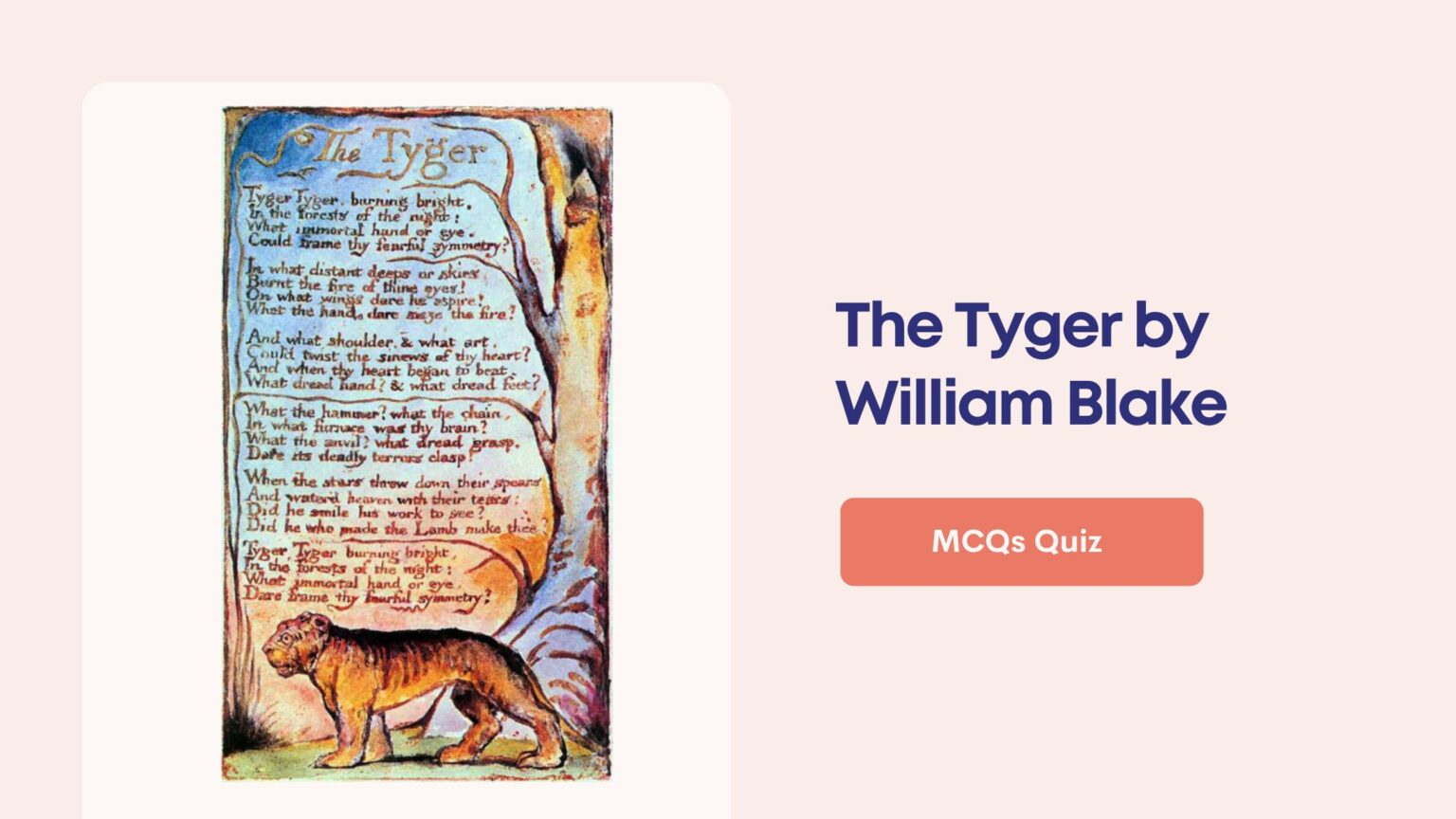1. When was William Blake born?
A. 1800
B. 1794
C. 1765
D. 1757
Answer: 1757 (D)
William Blake was born in London on the 28th of November 1757.
2. Which collection of works by William Blake includes ‘Songs of Innocence’ and ‘Songs of Experience’?
A. Songs of Revolution
B. The Lamb Collection
C. Songs of Creation
D. The Tyger Collection
Answer: The Tyger Collection (D)
‘Songs of Innocence’ and ‘Songs of Experience’ are primary collections in William Blake’s works.
3. What does ‘The Tiger’ poem explore?
A. Beauty in nature
B. Advantages of industrialization
C. Effects of child labor
D. Character of God and his works
Answer: Character of God and his works (D)
‘The Tiger’ explores the character of God and his works.
4. Which of the following is NOT addressed in William Blake’s poems?
A. Child labor
B. False portrayal of Christianity
C. Racial discrimination
D. Agricultural reform
Answer: Agricultural reform (D)
William Blake’s poems address racial discrimination, child labor, and the false portrayal of Christianity, but not agricultural reform.
5. In what collection was the poem ‘The Lamb’ first published?
A. ‘Songs of Creation’
B. ‘Songs of Innocence’
C. ‘Songs of Revolution’
D. ‘The Tyger Collection’
Answer: ‘Songs of Innocence’ (B)
‘The Lamb’ was first published in William Blake’s book ‘Songs of Innocence’ in 1789.
6. What is a key contribution of William Blake to the arts?
A. Inventing surrealism
B. Introducing impressionism
C. Creating abstract art
D. Pioneering Romantic-era English poetry and painting
Answer: Pioneering Romantic-era English poetry and painting (D)
William Blake was recognized for developing Romantic-era English poetry and painting.
7. Which pair of poems by William Blake are closely related?
A. ‘The Tiger’ and ‘The Zebra’
B. ‘The Lamb’ and ‘The Tyger’
C. ‘The Lion’ and ‘The Bear’
D. ‘The Elephant’ and ‘The Rhino’
Answer: ‘The Lamb’ and ‘The Tyger’ (B)
‘The Lamb’ and ‘The Tyger’ are closely related poems by William Blake.
8. ‘Songs of Experience’ and ‘Songs of Innocence’ are collections known for their focus on:
A. ‘Nature’
B. ‘Social Issues’
C. ‘Spirituality’
D. ‘Romantic Love’
Answer: ‘Social Issues’ (B)
‘Songs of Experience’ and ‘Songs of Innocence’ focus on social issues like innocence, experience, and the problem of evil.
9. ‘The Tiger’ poem compares which two elements?
A. ‘Aesthetic beauty’ and ‘Instinctive aggression’
B. ‘Humanity’ and ‘Divinity’
C. ‘Life’ and ‘Death’
D. ‘Beauty in nature’ and ‘Loss of innocence’
Answer: ‘Aesthetic beauty’ and ‘Instinctive aggression’ (A)
‘The Tiger’ compares aesthetic beauty and instinctive aggression.
10. What era is reflected in William Blake’s paintings?
A. ‘Realism Era’
B. ‘Baroque Era’
C. ‘Romantic Era’
D. ‘Renaissance Era’
Answer: ‘Romantic Era’ (C)
William Blake’s paintings reflect the Romantic era.
11. What is the main theme of the poem “The Tyger”?
A. The duality of creation and destruction
B. The contrast between innocence and experience
C. The fear of the unknown
D. The beauty and power of nature
Answer: The duality of creation and destruction (A)
The poem explores the opposing forces of creation represented by the tiger, and questions the nature of the creator who made both the fearsome tiger and the gentle lamb.
12. What poetic device does Blake use to emphasize the tiger’s fearsome appearance?
A. Metaphor
B. Alliteration
C. Simile
D. Personification
Answer: Alliteration (B)
Blake uses alliteration with phrases like “burning bright” and “forests of the night” to create a vivid and intense image of the tiger.
13. What is the rhyme scheme of the poem?
A. ABCB
B. ABAB
C. The rhyme scheme varies
D. AABB
Answer: ABAB (B)
The poem follows an ABAB rhyme scheme, with the second and fourth lines of each stanza rhyming.
14. Which poetic meter is primarily used in the poem?
A. Dactylic hexameter
B. Iambic pentameter
C. Anapestic trimeter
D. Trochaic tetrameter
Answer: Trochaic tetrameter (D)
The poem is primarily written in catalectic trochaic tetrameter, with a few lines in iambic tetrameter.
15. What does the poet wonder about the tiger’s creator in the second stanza?
A. The strength of the creator’s hands to handle fire
B. The location where the fire for the tiger’s eyes was created
C. The method used to twist the tiger’s sinews
D. All of the above
Answer: All of the above (D)
The second stanza questions the source of the fire in the tiger’s eyes, the wings needed to reach that source, and the strength required to twist the tiger’s sinews.
16. What does the poet compare the tiger’s creation process to in the fourth stanza?
A. A blacksmith’s work
B. A weaver’s work
C. A potter’s work
D. A sculptor’s work
Answer: A blacksmith’s work (A)
The poet imagines the tiger’s creation as a blacksmith’s work, with tools like a hammer, chain, furnace, and anvil.
17. What is the significance of the line “Did he who made the Lamb make thee?”
A. It suggests the tiger and lamb were created separately
B. It compares the tiger to the lamb
C. It questions the nature of the creator
D. Both A and B
Answer: Both A and B (D)
This line questions how the same creator could make both the gentle lamb and the fearsome tiger, highlighting the contrast between innocence and experience.
18. What is the tone of the poem towards the tiger?
A. Fearful
B. Admiring
C. Indifferent
D. Questioning
Answer: Questioning (D)
The poem takes a questioning and contemplative tone towards the tiger, wondering about its creation and the nature of its creator.
19. What does the repetition of the first and last stanzas suggest?
A. The cyclical nature of life
B. The poet’s obsession with the tiger
C. The tiger’s eternal presence in the forest
D. The unanswered questions about the tiger’s creation
Answer: The unanswered questions about the tiger’s creation (D)
The repetition of the opening and closing stanzas emphasizes the lingering questions about the tiger’s fearful symmetry and the nature of its creator.
20. What is the significance of the stars “throwing down their spears” and “water’d heaven with their tears”?
A. It implies the stars were involved in the tiger’s creation
B. It represents the awe and fear inspired by the tiger’s creation
C. It suggests the tiger was created in heaven
D. It symbolizes the tiger’s destructive power
Answer: It represents the awe and fear inspired by the tiger’s creation (B)
This metaphorical image represents the awe and fear inspired by the creation of the tiger, so powerful that even the stars were moved to tears.
21. What does the Tiger represent in Blake’s poem?
A. A metaphor for nature’s beauty and fury
B. An allegory for the human soul
C. A representation of the industrial revolution
D. A symbol of God’s creation
Answer: A metaphor for nature’s beauty and fury (A)
The Tiger is contrasted with the dark forest, representing a powerful force that sheds light on the darkest parts of the mind. It also symbolizes the simultaneous beauty and fury of nature.
22. How is the Tiger described in relation to God?
A. The Tiger is a symbol of God’s weakness
B. The Tiger is a rival to God’s power
C. The Tiger is a creation of God’s divine might
D. The Tiger is a representation of God’s wrath
Answer: The Tiger is a creation of God’s divine might (C)
The text states that the Tiger is a creation of the Christian God, whose dominion includes all creation, implying that the Tiger is a product of God’s divine might.
23. What does Blake suggest about the paradox of creation?
A. Creation is a reflection of God’s perfection
B. Creation is inherently flawed and imperfect
C. Creation is a balance between innocence and experience
D. Creation is a product of the industrial revolution
Answer: Creation is a balance between innocence and experience (C)
The text states that Blake suggests a paradox of creation, which is based on two forces, innocence and experience or violence, created from the outset and designed to oppose each other.
24. What does the speaker’s voice represent in the poem?
A. The voice of the Tiger itself
B. The voice of God
C. The voice of the bardic prophet
D. The voice of the industrial revolution
Answer: The voice of the bardic prophet (C)
The text states that in Songs of Innocence and Songs of Experience, Blake mostly uses the bardic prophet’s voice, which is evident in this poem.
25. How does Blake portray God’s creation in the poem?
A. As a reflection of the industrial revolution
B. As a paradoxical combination of innocence and experience
C. As a perfect and flawless process
D. As a violent and destructive force
Answer: As a paradoxical combination of innocence and experience (B)
The text suggests that Blake portrays God’s creation as a paradox, combining innocence and violence or experience, which are designed to oppose each other.
26. What is the significance of the “fire” and “furnace” imagery in the poem?
A. It represents the destructive nature of the Tiger
B. It represents the industrial revolution
C. It represents the enlightenment of the speaker
D. It represents the creative power of God
Answer: It represents the creative power of God (D)
The text states that the poem uses words like “fire” and “furnace” to express lighting, which is associated with the creative power of God in creating the Tiger.
27. How does the poem suggest that the Tiger interacts with humans?
A. The Tiger is specifically created for interaction with humans
B. The Tiger is a threat to human existence
C. The Tiger is a companion to human beings
D. The Tiger is indifferent to human beings
Answer: The Tiger is specifically created for interaction with humans (A)
The text implies that a heavenly architect created the terrifying Tiger specifically for interaction with people.
28. What does the poem suggest about the impact of the industrial revolution?
A. It had a spiritual impact on people’s lives
B. It had a negative impact on workers and production
C. It had a positive impact on rural life
D. It had no significant impact on society
Answer: It had a negative impact on workers and production (B)
The text states that the work in industrial environments hurts workers and production, comparing it to the harm inflicted on lambs in the companion poem.
29. What is the central idea behind the poem’s use of religious symbolism?
A. To celebrate the power of nature
B. To promote the bardic prophet’s teachings
C. To question the existence of God
D. To explore the paradoxical nature of God’s creation
Answer: To explore the paradoxical nature of God’s creation (D)
The poem uses religious references and symbolism to explore the paradox of God’s creation, which combines both innocence and violence or experience.
30. What does the poem suggest about the relationship between humans and God?
A. Humans are inferior to God’s other creations
B. Humans have no connection to God’s creations
C. Humans are superior to God’s creations
D. Humans are equal to God’s other creations
Answer: Humans are equal to God’s other creations (D)
The text suggests that in God’s eyes, human beings are seen as equal to other creations like the Tiger, as both are uniquely created by God, but also imperfect.



